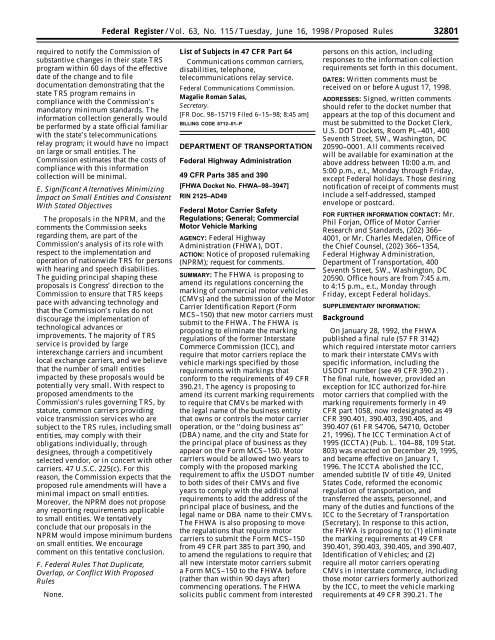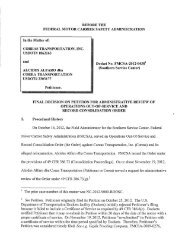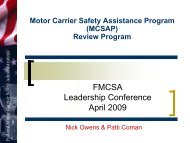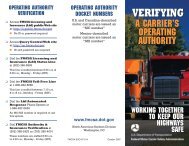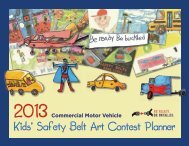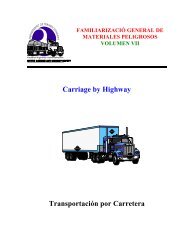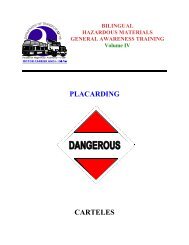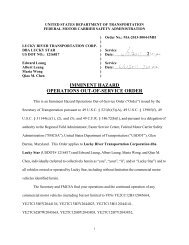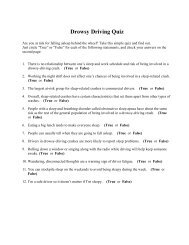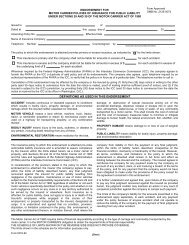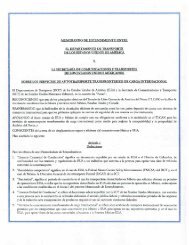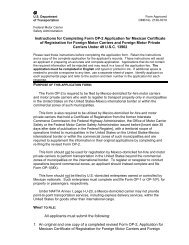View/Print PDF File - Federal Motor Carrier Safety Administration
View/Print PDF File - Federal Motor Carrier Safety Administration
View/Print PDF File - Federal Motor Carrier Safety Administration
Create successful ePaper yourself
Turn your PDF publications into a flip-book with our unique Google optimized e-Paper software.
<strong>Federal</strong> Register / Vol. 63, No. 115 / Tuesday, June 16, 1998 / Proposed Rules<br />
required to notify the Commission of<br />
substantive changes in their state TRS<br />
program within 60 days of the effective<br />
date of the change and to file<br />
documentation demonstrating that the<br />
state TRS program remains in<br />
compliance with the Commission’s<br />
mandatory minimum standards. The<br />
information collection generally would<br />
be performed by a state official familiar<br />
with the state’s telecommunications<br />
relay program; it would have no impact<br />
on large or small entities. The<br />
Commission estimates that the costs of<br />
compliance with this information<br />
collection will be minimal.<br />
E. Significant Alternatives Minimizing<br />
Impact on Small Entities and Consistent<br />
With Stated Objectives<br />
The proposals in the NPRM, and the<br />
comments the Commission seeks<br />
regarding them, are part of the<br />
Commission’s analysis of its role with<br />
respect to the implementation and<br />
operation of nationwide TRS for persons<br />
with hearing and speech disabilities.<br />
The guiding principal shaping these<br />
proposals is Congress’ direction to the<br />
Commission to ensure that TRS keeps<br />
pace with advancing technology and<br />
that the Commission’s rules do not<br />
discourage the implementation of<br />
technological advances or<br />
improvements. The majority of TRS<br />
service is provided by large<br />
interexchange carriers and incumbent<br />
local exchange carriers, and we believe<br />
that the number of small entities<br />
impacted by these proposals would be<br />
potentially very small. With respect to<br />
proposed amendments to the<br />
Commission’s rules governing TRS, by<br />
statute, common carriers providing<br />
voice transmission services who are<br />
subject to the TRS rules, including small<br />
entities, may comply with their<br />
obligations individually, through<br />
designees, through a competitively<br />
selected vendor, or in concert with other<br />
carriers. 47 U.S.C. 225(c). For this<br />
reason, the Commission expects that the<br />
proposed rule amendments will have a<br />
minimal impact on small entities.<br />
Moreover, the NPRM does not propose<br />
any reporting requirements applicable<br />
to small entities. We tentatively<br />
conclude that our proposals in the<br />
NPRM would impose minimum burdens<br />
on small entities. We encourage<br />
comment on this tentative conclusion.<br />
F. <strong>Federal</strong> Rules That Duplicate,<br />
Overlap, or Conflict With Proposed<br />
Rules<br />
None.<br />
List of Subjects in 47 CFR Part 64<br />
Communications common carriers,<br />
disabilities, telephone,<br />
telecommunications relay service.<br />
<strong>Federal</strong> Communications Commission.<br />
Magalie Roman Salas,<br />
Secretary.<br />
[FR Doc. 98–15719 <strong>File</strong>d 6–15–98; 8:45 am]<br />
BILLING CODE 6712–01–P<br />
DEPARTMENT OF TRANSPORTATION<br />
<strong>Federal</strong> Highway <strong>Administration</strong><br />
49 CFR Parts 385 and 390<br />
[FHWA Docket No. FHWA–98–3947]<br />
RIN 2125–AD49<br />
<strong>Federal</strong> <strong>Motor</strong> <strong>Carrier</strong> <strong>Safety</strong><br />
Regulations; General; Commercial<br />
<strong>Motor</strong> Vehicle Marking<br />
AGENCY: <strong>Federal</strong> Highway<br />
<strong>Administration</strong> (FHWA), DOT.<br />
ACTION: Notice of proposed rulemaking<br />
(NPRM); request for comments.<br />
SUMMARY: The FHWA is proposing to<br />
amend its regulations concerning the<br />
marking of commercial motor vehicles<br />
(CMVs) and the submission of the <strong>Motor</strong><br />
<strong>Carrier</strong> Identification Report (Form<br />
MCS–150) that new motor carriers must<br />
submit to the FHWA. The FHWA is<br />
proposing to eliminate the marking<br />
regulations of the former Interstate<br />
Commerce Commission (ICC), and<br />
require that motor carriers replace the<br />
vehicle markings specified by those<br />
requirements with markings that<br />
conform to the requirements of 49 CFR<br />
390.21. The agency is proposing to<br />
amend its current marking requirements<br />
to require that CMVs be marked with<br />
the legal name of the business entity<br />
that owns or controls the motor carrier<br />
operation, or the ‘‘doing business as’’<br />
(DBA) name, and the city and State for<br />
the principal place of business as they<br />
appear on the Form MCS–150. <strong>Motor</strong><br />
carriers would be allowed two years to<br />
comply with the proposed marking<br />
requirement to affix the USDOT number<br />
to both sides of their CMVs and five<br />
years to comply with the additional<br />
requirements to add the address of the<br />
principal place of business, and the<br />
legal name or DBA name to their CMVs.<br />
The FHWA is also proposing to move<br />
the regulations that require motor<br />
carriers to submit the Form MCS–150<br />
from 49 CFR part 385 to part 390, and<br />
to amend the regulations to require that<br />
all new interstate motor carriers submit<br />
a Form MCS–150 to the FHWA before<br />
(rather than within 90 days after)<br />
commencing operations. The FHWA<br />
solicits public comment from interested<br />
32801<br />
persons on this action, including<br />
responses to the information collection<br />
requirements set forth in this document.<br />
DATES: Written comments must be<br />
received on or before August 17, 1998.<br />
ADDRESSES: Signed, written comments<br />
should refer to the docket number that<br />
appears at the top of this document and<br />
must be submitted to the Docket Clerk,<br />
U.S. DOT Dockets, Room PL–401, 400<br />
Seventh Street, SW., Washington, DC<br />
20590–0001. All comments received<br />
will be available for examination at the<br />
above address between 10:00 a.m. and<br />
5:00 p.m., e.t., Monday through Friday,<br />
except <strong>Federal</strong> holidays. Those desiring<br />
notification of receipt of comments must<br />
include a self-addressed, stamped<br />
envelope or postcard.<br />
FOR FURTHER INFORMATION CONTACT: Mr.<br />
Phil Forjan, Office of <strong>Motor</strong> <strong>Carrier</strong><br />
Research and Standards, (202) 366–<br />
4001, or Mr. Charles Medalen, Office of<br />
the Chief Counsel, (202) 366–1354,<br />
<strong>Federal</strong> Highway <strong>Administration</strong>,<br />
Department of Transportation, 400<br />
Seventh Street, SW., Washington, DC<br />
20590. Office hours are from 7:45 a.m.<br />
to 4:15 p.m., e.t., Monday through<br />
Friday, except <strong>Federal</strong> holidays.<br />
SUPPLEMENTARY INFORMATION:<br />
Background<br />
On January 28, 1992, the FHWA<br />
published a final rule (57 FR 3142)<br />
which required interstate motor carriers<br />
to mark their interstate CMVs with<br />
specific information, including the<br />
USDOT number (see 49 CFR 390.21) .<br />
The final rule, however, provided an<br />
exception for ICC authorized for-hire<br />
motor carriers that complied with the<br />
marking requirements formerly in 49<br />
CFR part 1058, now redesignated as 49<br />
CFR 390.401, 390.403, 390.405, and<br />
390.407 (61 FR 54706, 54710, October<br />
21, 1996). The ICC Termination Act of<br />
1995 (ICCTA) (Pub. L. 104–88, 109 Stat.<br />
803) was enacted on December 29, 1995,<br />
and became effective on January 1,<br />
1996. The ICCTA abolished the ICC,<br />
amended subtitle IV of title 49, United<br />
States Code, reformed the economic<br />
regulation of transportation, and<br />
transferred the assets, personnel, and<br />
many of the duties and functions of the<br />
ICC to the Secretary of Transportation<br />
(Secretary). In response to this action,<br />
the FHWA is proposing to: (1) eliminate<br />
the marking requirements at 49 CFR<br />
390.401, 390.403, 390.405, and 390.407,<br />
Identification of Vehicles; and (2)<br />
require all motor carriers operating<br />
CMVs in interstate commerce, including<br />
those motor carriers formerly authorized<br />
by the ICC, to meet the vehicle marking<br />
requirements at 49 CFR 390.21. The
32802 <strong>Federal</strong> Register / Vol. 63, No. 115 / Tuesday, June 16, 1998 / Proposed Rules<br />
FHWA believes it is important that<br />
CMVs be properly marked so that the<br />
public has an effective means to identify<br />
motor carriers operating in an unsafe<br />
manner. Such markings will assist State<br />
officials conducting roadside<br />
inspections and accident investigations<br />
in attributing important safety data to<br />
the correct motor carrier.<br />
Use of the <strong>Motor</strong> <strong>Carrier</strong> Identification<br />
Number<br />
The FHWA regulates the safety<br />
aspects of interstate motor carrier<br />
operations. All motor carriers must file<br />
a motor carrier identification report<br />
(Form MCS–150) with the FHWA<br />
within 90 days after beginning interstate<br />
operations. Shortly after the receipt of a<br />
completed Form MCS–150, the FHWA<br />
assigns a USDOT number to the motor<br />
carrier and notifies it of the number<br />
assigned.<br />
The <strong>Motor</strong> <strong>Carrier</strong> Management<br />
Information System (MCMIS) is a<br />
computerized information system<br />
containing comprehensive safety<br />
performance data on individual<br />
interstate motor carriers. These data are<br />
supplied by State and <strong>Federal</strong> motor<br />
carrier safety personnel and the motor<br />
carriers themselves. The data are<br />
maintained on a central mainframe<br />
computer and are available for use by<br />
States, <strong>Federal</strong> agencies, the motor<br />
carrier industry, insurance companies,<br />
and others.<br />
All safety performance data on each<br />
motor carrier are linked to the USDOT<br />
number. This includes roadside<br />
inspection data, accident data,<br />
including safety and compliance review<br />
information. The USDOT number is<br />
used to link data together to produce<br />
summaries or reports on specific motor<br />
carriers. These data are often used to<br />
establish priorities for motor carrier<br />
educational and enforcement activities<br />
by both <strong>Federal</strong> and State agencies.<br />
Thus, one of the ultimate goals of the<br />
MCMIS is to receive adequate and<br />
reliable safety performance data on each<br />
individual carrier to support overall<br />
trends and evaluate program<br />
effectiveness.<br />
It is extremely difficult, however, to<br />
produce an accurate report of a motor<br />
carrier’s safety performance without the<br />
use of a unique identifying data element<br />
for that motor carrier. The identity of<br />
the motor carrier cannot always be<br />
determined from the data recorded on<br />
the roadside inspection report. For<br />
example, many motor carriers in the<br />
United States and Canada have the same<br />
or similar names. In addition, many<br />
motor carriers have regional and<br />
terminal offices separate from their<br />
principal place of business. Yet, any of<br />
these addresses is currently acceptable<br />
under § 390.21(b)(2). Likewise, use of<br />
multiple names and addresses by motor<br />
carriers makes it difficult for the FHWA<br />
to match roadside inspection data with<br />
a specific motor carrier in the MCMIS.<br />
During calendar year 1996, 212,712 of<br />
the 1,479,259 roadside inspections<br />
could not be matched to the correct<br />
motor carrier. Excessive resources are<br />
expended in an attempt to resolve this<br />
continuing ‘‘non-match’’ problem.<br />
Accordingly, the FHWA is proposing<br />
this action to better identify and match<br />
safety performance data with the correct<br />
motor carrier.<br />
Legal Name or Trade Name<br />
The FHWA proposes to require a<br />
motor carrier to mark both sides of each<br />
self-propelled CMV it operates with the<br />
legal name or the name under which the<br />
carrier does business (DBA name), as<br />
that name is shown on the Form MCS–<br />
150. The current marking requirement<br />
in § 390.21(b)(1) allows the motor<br />
carrier to use its ‘‘name or trade name,’’<br />
but does not require that name to be the<br />
same name as the motor carrier listed on<br />
its Form MCS–150. The MCMIS only<br />
contains the legal name and a single<br />
trade (DBA) name and, therefore, is<br />
limited in its ability to correctly match<br />
inspection reports with motor carriers.<br />
This proposed change is intended to<br />
improve identification methods so that<br />
States can assign performance data to<br />
the correct motor carrier. This action<br />
will help alleviate the ‘‘non-match’’<br />
problem that currently exists.<br />
A reliable means of correctly<br />
identifying motor carriers is critical,<br />
given: (1) the trend toward ‘‘automated<br />
roadside inspections’’; (2) ‘‘electronic<br />
clearance’’ technologies being explored<br />
through the Intelligent Transportation<br />
System (ITS) program (formerly known<br />
as the Intelligent Vehicle-Highway<br />
Systems program), under authority<br />
granted by the Intelligent Vehicle-<br />
Highway Systems Act of 1991 (IVHS)<br />
(secs. 6051–6059 of the Intermodal<br />
Surface Transportation Efficiency Act of<br />
1991 (ISTEA), Pub. L. 102–240, 105 Stat.<br />
1914, 2189–2195); (3) the increasing<br />
costs of conducting roadside<br />
inspections; (4) the FHWA’s growing<br />
reliance on ‘‘performance data’’; and (5)<br />
the need for more efficient methods of<br />
evaluating the safety fitness of motor<br />
carriers.<br />
The FHWA believes that the number<br />
of motor carriers affected by this change<br />
will be relatively small. The precise<br />
number cannot, however, be determined<br />
from existing databases. <strong>Motor</strong> carriers<br />
with multiple trade names would be<br />
permitted to decide upon a DBA name<br />
with which to mark their CMVs and to<br />
notify the FHWA by submitting a<br />
revised Form MCS–150. The FHWA<br />
does not want to impose additional<br />
financial hardship upon the motor<br />
carriers. Therefore, the USDOT number<br />
would not need to be marked on<br />
existing CMVs until two years after the<br />
publication of the rule and the motor<br />
carrier would have five years from the<br />
publication of the rule to affix the legal<br />
name or DBA name on both sides of<br />
their CMVs.<br />
Principal Place of Business Address<br />
Required on CMVs<br />
The FHWA also proposes to remove<br />
the language in § 390.21(b)(2) that<br />
allows a motor carrier to mark its CMVs<br />
by displaying the address where the<br />
vehicle is customarily based. The<br />
FHWA would require a motor carrier to<br />
mark its CMVs only with the address of<br />
its principal place of business. A single<br />
address, like the single name discussed<br />
in the previous section, would<br />
significantly increase the ability of<br />
enforcement personnel at an accident<br />
scene, or a roadside inspection, to<br />
properly identify the motor carrier and<br />
ensure that data collected is assigned to<br />
the proper motor carrier. This new<br />
requirement would apply to the entire<br />
fleet, including those CMVs located at a<br />
terminal office. The motor carrier would<br />
have five years from the effective date<br />
of the rule to affix the address of the<br />
principal place of business on both<br />
sides of their CMVs.<br />
New <strong>Carrier</strong>s Required to <strong>File</strong> MCS–150<br />
Before Commencing Operations<br />
The FHWA is proposing to amend the<br />
requirement under which new motor<br />
carriers must file the Form MCS–150.<br />
The current requirement allows a new<br />
motor carrier to file Form MCS–150<br />
within 90 days after beginning<br />
operations. The proposed change would<br />
require all new motor carriers to file<br />
Form MCS–150 before commencing<br />
operations. The FHWA has streamlined<br />
the process for filing the Form MCS–150<br />
by making it available on the Internet.<br />
<strong>Motor</strong> carriers calling for the Form<br />
MCS–150 may access the Internet<br />
through the DOT WEB page at: ‘‘HTTP:/<br />
/WWW.FHWA.DOT.GOV/OMC/<br />
OMCHOME.HTML’’. <strong>Motor</strong> carriers can<br />
download the Form MCS–150, complete<br />
it, and submit it by mail. <strong>Carrier</strong>s may<br />
also obtain copies of the form from the<br />
FHWA Regional Offices listed in<br />
§ 390.27.<br />
Proposed Implementation Plan<br />
The FHWA recognizes that the time it<br />
would take a motor carrier to bring a<br />
large fleet into compliance with a new<br />
vehicle marking rule may be significant.
<strong>Federal</strong> Register / Vol. 63, No. 115 / Tuesday, June 16, 1998 / Proposed Rules<br />
Under this proposal, all CMVs that are<br />
part of a motor carrier’s existing fleet on<br />
the effective date of this rule, and which<br />
are marked currently with an ICC MC<br />
number, would have two years to come<br />
into compliance with the proposed<br />
marking requirements as they apply to<br />
the USDOT number. When the ICC was<br />
terminated, most for-hire carriers<br />
removed the ICC acronym from their<br />
CMVs. The FHWA now issues only the<br />
MC number to the for-hire carriers.<br />
Thus, the former ICC MC number will<br />
be referred to only as the ‘‘MC’’ number<br />
in this document. A motor carrier would<br />
not be required to remove the MC<br />
number when it affixes the USDOT<br />
number, but may do so if it wishes. All<br />
CMVs added to a motor carrier fleet<br />
after the effective date of a final rule<br />
would be required to meet all of the<br />
marking requirements, including<br />
marking CMVs with the legal name or<br />
the name under which it does business<br />
(DBA name), as that name is shown on<br />
the Form MCS–150, and marking CMVs<br />
only with the address of its principal<br />
place of business.<br />
The FHWA believes that two years<br />
would be a sufficient period of time for<br />
the motor carrier to meet the proposed<br />
marking requirements for adding the<br />
USDOT number, and five years to affix<br />
the address of the principal place of<br />
business, and the legal name or DBA<br />
name on both sides of their CMVs,<br />
without creating either an<br />
administrative or economic hardship for<br />
motor carriers.<br />
<strong>Motor</strong> <strong>Carrier</strong> Identification Report<br />
(Section 385.21), Failure to Report<br />
(Section 385.23), and Form MCS–150,<br />
<strong>Motor</strong> <strong>Carrier</strong> Identification Report<br />
(Appendix to Part 385)<br />
The FHWA proposes to remove<br />
§§ 385.21 and 385.23 and combine the<br />
requirements of those two sections into<br />
a new § 390.19, <strong>Motor</strong> <strong>Carrier</strong><br />
Identification Report. Form MCS–150,<br />
which is now an appendix to part 385,<br />
would be redesignated as an appendix<br />
to part 390. This proposed change<br />
would place the Form MCS–150 and the<br />
CMV marking requirements in the same<br />
part of the <strong>Federal</strong> <strong>Motor</strong> <strong>Carrier</strong> <strong>Safety</strong><br />
Regulations (FMCSRs). The items<br />
proposed in this NPRM may change the<br />
information required to be on the MCS–<br />
150 (e.g., references to the ICC). The<br />
FHWA will make the appropriate<br />
changes after a review of the docket<br />
comments and the existing supply of<br />
MCS–150s in stock is depleted.<br />
States Encouraged To Require USDOT<br />
Numbers for Intrastate <strong>Motor</strong> <strong>Carrier</strong>s<br />
The FHWA intends to allow and<br />
encourage the States to issue USDOT<br />
numbers to intrastate motor carriers.<br />
Currently, USDOT numbers are issued<br />
only by the FHWA to motor carriers<br />
engaged in interstate commerce. In the<br />
interest of uniformity and positive<br />
identification of all motor carriers<br />
engaged in commerce, the FHWA<br />
encourages the States to require their<br />
intrastate motor carriers to file Form<br />
MCS–150, or a similar form, with an<br />
appropriate State office. Upon receipt of<br />
the completed document, the States<br />
would record the information, assign<br />
the motor carrier a USDOT number from<br />
the FHWA database, and notify the<br />
motor carrier of its new number. If the<br />
States are willing to accept this<br />
responsibility, they would also need to<br />
require intrastate motor carriers to mark<br />
their CMVs with the USDOT number,<br />
and company name and address, in the<br />
same manner as proposed in this<br />
document.<br />
The FHWA program initiatives have<br />
been directed toward uniform safety<br />
regulations for the motor carrier<br />
industry. The desire for uniformity was<br />
also expressed by much of the motor<br />
carrier industry via docket submissions,<br />
public hearings, and nominal group<br />
process meetings conducted as part of<br />
the public outreach portion of the<br />
FHWA’s Zero Base Review of the<br />
FMCSRs. Having the various States and<br />
other government agencies use the<br />
USDOT number nationwide as the<br />
single motor carrier identifier would be<br />
a major step in achieving uniformity.<br />
The USDOT number could also serve as<br />
a motor carrier’s designated identifier<br />
for the base-State programs mandated by<br />
the ISTEA. Since September 30, 1996,<br />
States may collect motor carrier fuel tax<br />
and registration fees only through base-<br />
State agreements, such as the<br />
International Registration Plan (IRP) and<br />
the International Fuel Tax Agreement<br />
(IFTA).<br />
The <strong>Motor</strong> <strong>Carrier</strong> <strong>Safety</strong> Assistance<br />
Program (MCSAP) has increased its<br />
emphasis on traffic enforcement for<br />
CMVs over the last several years. These<br />
enforcement activities are performed by<br />
State enforcement officials and local<br />
officers who may not be familiar with<br />
motor carrier operations. Having the<br />
USDOT number as the single identifier<br />
for all motor carriers would ensure that<br />
the information collected at the roadside<br />
would be maintained in the correct<br />
motor carrier file.<br />
The Commercial Vehicle Operations<br />
(CVO) component of the ITS program is<br />
another area where adoption of the<br />
USDOT number by States would<br />
enhance uniformity. The following are<br />
specific examples of ITS/CVO<br />
technology:<br />
32803<br />
(1) electronic clearance of State and<br />
international borders by drivers and<br />
CMVs which are both legal and safe; (2)<br />
faster and more effective automated<br />
roadside inspections of commercial<br />
motor vehicles; (3) on-board safety<br />
devices to monitor driver alertness,<br />
vehicle defects, or other problems while<br />
the vehicle is in motion, and if<br />
necessary to notify the driver, carrier,<br />
and possibly enforcement personnel; (4)<br />
electronic purchase of credentials, and<br />
automated mileage and fuel reporting<br />
and auditing; (5) real-time<br />
communications between drivers,<br />
dispatchers, and intermodal<br />
transportation providers with<br />
information on congestion and routing<br />
options; and (6) hazardous materials<br />
(HM) incident notification which would<br />
provide HM response teams with timely<br />
and accurate information on cargo<br />
compartment contents, enabling them to<br />
react properly in emergency situations.<br />
An integrated information system<br />
capable of handling functions such as<br />
these is critically dependent upon a<br />
unique identifying number. The FHWA<br />
believes that the USDOT number can<br />
meet these needs.<br />
Mexican and Canadian <strong>Carrier</strong>s Also<br />
Subject to CMV Marking Requirements<br />
Mexico-based motor carriers who are<br />
presently operating under an MX<br />
number, and Canadian motor carriers<br />
operating under an MC number will also<br />
be required to meet all the CMV<br />
marking requirements proposed in this<br />
rule when operating in the United<br />
States.<br />
Transportation Lawyers Association<br />
Petitions for Rulemaking<br />
The Transportation Lawyers<br />
Association (TLA) filed a petition on<br />
March 2, 1994, requesting that the<br />
FHWA initiate a rulemaking to require<br />
motor carriers to file a Form MCS–150<br />
biennially and within 20 days following<br />
a change of its name, control,<br />
ownership, or its principal place of<br />
business. The TLA also recommended<br />
that the FHWA amend its Form MCS–<br />
150 to include blocks for motor carrier<br />
revenue, mileage, and accident data.<br />
On August 26, 1996, the FHWA<br />
published an advance notice of<br />
proposed rulemaking (ANPRM), <strong>Motor</strong><br />
<strong>Carrier</strong> Replacement Information/<br />
Registration System [61 FR 43816] .<br />
That notice was published in response<br />
to 49 U.S.C. 13908, enacted by section<br />
103 of the ICCTA, which requires the<br />
Secretary to initiate a rulemaking<br />
proceeding to replace the current<br />
Department of Transportation<br />
identification number system, the single<br />
State registration system (49 U.S.C.
32804 <strong>Federal</strong> Register / Vol. 63, No. 115 / Tuesday, June 16, 1998 / Proposed Rules<br />
14504), the registration and licensing<br />
system (49 U.S.C. 13901–13905), and<br />
the financial responsibility information<br />
system with a single, on-line <strong>Federal</strong><br />
system. The review and improvement of<br />
these information systems (49 U.S.C.<br />
13906) will benefit the motor carrier<br />
industry, the States, the <strong>Federal</strong><br />
government, and the public. In that<br />
ANPRM, the FHWA requested public<br />
comment from interested persons and<br />
responses to specific questions, several<br />
of which address issues raised by the<br />
TLA petition: Should the FHWA retain<br />
the USDOT identification number<br />
system as is? Who should be included<br />
as contributors to and users of this<br />
system? How could the system be<br />
improved? Should Forms MCS–150,<br />
MCS–90 and MCS–82 be retained,<br />
modified or eliminated? Do they capture<br />
only the necessary information? Should<br />
the information on Form MCS–150 be<br />
updated periodically? If so, at what<br />
intervals? Because the rulemaking to<br />
implement 49 U.S.C.13908 is much<br />
broader than the TLA request, the<br />
FHWA has decided neither to grant nor<br />
deny the petition, but rather to file it as<br />
a docket comment to the August 26,<br />
1996, ANPRM. The FHWA encourages<br />
the TLA to participate actively in the<br />
future course of that rulemaking<br />
proceeding.<br />
Commercial Vehicle <strong>Safety</strong> Alliance<br />
Petitions for Regulatory Changes<br />
The Commercial Vehicle <strong>Safety</strong><br />
Alliance (CVSA) and the Steering<br />
Committee of the Commercial Vehicle<br />
Information System (CVIS) jointly<br />
petitioned the FHWA, on July 13, 1994,<br />
for a number of regulatory changes<br />
pertaining to marking requirements. The<br />
petitioners asked the FHWA to require<br />
all motor carriers to mark their vehicles<br />
with the USDOT number. As already<br />
discussed, the FHWA is proposing to<br />
eliminate the current rule which allows<br />
for-hire motor carriers operating under<br />
authority formerly issued by the ICC to<br />
mark their vehicles in accordance with<br />
49 CFR 390.401, 390.403, 390.405, and<br />
390.407 (Identification of Vehicles) in<br />
lieu of obtaining a USDOT number.<br />
When drivers, vehicles, and even<br />
motor carriers are operating under lease<br />
to other motor carriers, it is sometimes<br />
difficult for enforcement personnel to<br />
decide who is responsible for regulatory<br />
compliance. The CVSA and the CVIS<br />
Steering Committee, therefore, asked the<br />
FHWA to require the USDOT number of<br />
the party responsible for safety be listed<br />
on appropriate documents carried in<br />
each vehicle. The motor carrier (lessee)<br />
is always responsible for its employees<br />
under § 390.11. Petitioners suggested<br />
that the lease itself could be marked<br />
with the USDOT number, but marking<br />
the driver’s record of duty status would<br />
give the same information with minimal<br />
changes in current procedures.<br />
Petitioners also recommended that the<br />
FHWA ask the ICC (which has been<br />
abolished pursuant to the ICCTA) to<br />
amend: (1) 49 CFR part 1058 (now 49<br />
CFR part 390, subpart D) to require all<br />
motor carriers regulated by the ICC to<br />
obtain and display a USDOT number;<br />
and (2) part 1057 ( now 49 CFR part 376,<br />
Lease and Interchange of Vehicles), to<br />
require the inclusion of the USDOT<br />
number on all lease documents.<br />
Finally, the CVSA and the CVIS<br />
Steering Committee asked the FHWA to<br />
make the requirements of § 390.21<br />
applicable in some way to all intrastate<br />
motor carriers.<br />
The FHWA replied by letter on<br />
September 7, 1994, that it would not<br />
rule on the petition, but would simply<br />
allow the Office of <strong>Motor</strong> <strong>Carrier</strong>s to<br />
proceed with this rulemaking, which<br />
began some months before the CVSA<br />
and the CVIS Steering Committee<br />
approached the agency. The FHWA<br />
believes this NPRM addresses the<br />
concerns expressed by the petitioners.<br />
The proposed rule would require all<br />
motor carriers subject to the FMCSRs,<br />
including those motor carriers formerly<br />
regulated by the ICC, to comply with the<br />
CMV marking requirements set forth in<br />
§ 390.21. However, the FHWA has no<br />
direct authority to impose marking<br />
requirements on intrastate motor<br />
carriers. As stated previously, the<br />
agency will actively encourage the<br />
States to issue all intrastate motor<br />
carriers USDOT numbers which will<br />
serve as the single national identifier.<br />
The petitioners’ request that the FHWA<br />
require the USDOT number of the party<br />
responsible for safety be listed on<br />
appropriate documents is not addressed<br />
in this rulemaking, because that issue<br />
will be the subject of a subsequent<br />
rulemaking.<br />
Rulemaking Analyses and Notices<br />
All comments received before the<br />
close of business on the comment<br />
closing date indicated in the DATES<br />
section will be considered and will be<br />
available for examination in the docket<br />
room indicated in the ADDRESSES<br />
section. Comments received after the<br />
comment closing date will be filed in<br />
the docket and will be considered to the<br />
extent practicable, but the FHWA may<br />
issue a final rule at any time after the<br />
close of the comment period. In<br />
addition to late comments, the FHWA<br />
will also continue to file in the docket<br />
relevant information that becomes<br />
available after the comment period<br />
closing date. Interested persons should<br />
examine the docket for new material.<br />
Executive Order 12866 (Regulatory<br />
Planning and Review) and DOT<br />
Regulatory Policies and Procedures<br />
This document proposes to amend<br />
part 390 to require that all CMVs that<br />
are part of a motor carrier’s existing fleet<br />
on the effective date of this rule and<br />
which are marked currently with MC<br />
numbers, also mark those vehicles with<br />
their assigned USDOT number and<br />
correct name and address (city and<br />
state) if necessary. <strong>Motor</strong> carriers would<br />
be given two years from the date this<br />
rule becomes effective to affix the<br />
USDOT number to the vehicles in their<br />
existing fleet. <strong>Motor</strong> carriers would have<br />
five years from the date this rule<br />
becomes effective to affix the address of<br />
the principal place of business, and the<br />
legal name or DBA name on both sides<br />
of their CMVs, as shown on the <strong>Motor</strong><br />
<strong>Carrier</strong> Identification Report, Form<br />
MCS–150. <strong>Motor</strong> carriers would not be<br />
required to remove the MC numbers<br />
from vehicles in their existing fleet, but<br />
would be prohibited from displaying the<br />
MC numbers on new vehicles entering<br />
the fleet. All CMVs added to a motor<br />
carrier’s fleet after the effective date of<br />
a final rule in this proceeding would be<br />
required to meet all the proposed<br />
marking requirements prior to the<br />
vehicles being put into service.<br />
The FHWA has determined that this<br />
document is a significant regulatory<br />
action under Executive Order 12866 and<br />
is significant under the DOT’s<br />
regulatory policies and procedures. A<br />
regulatory evaluation was prepared, and<br />
has been placed in the docket. This<br />
evaluation shows that this proposed<br />
rule would cost carriers approximately<br />
$10.7 million spread over a five-year<br />
phase-in period. The discounted cost,<br />
based on a 7 percent discounted rate,<br />
would be $9.2 million.<br />
The benefits of this rule, although<br />
significant, are difficult to quantify. The<br />
primary benefit would be an<br />
improvement in the FHWA’s ability to<br />
identify problem carriers and to take<br />
action to reduce the potential for harm<br />
from these carriers. The action taken<br />
would depend upon the severity of the<br />
problem. Dangerous or unsafe carriers,<br />
such as those with a consistently high<br />
out-of-service (OOS) rate or a greater<br />
than expected number of accidents,<br />
could be forced to discontinue<br />
operations. <strong>Carrier</strong>s with less severe<br />
problems could be targeted for<br />
educational and other enforcement<br />
actions. While FHWA programs cannot<br />
entirely eliminate the threat from unsafe<br />
carriers, we believe that the<br />
combination of educational and
<strong>Federal</strong> Register / Vol. 63, No. 115 / Tuesday, June 16, 1998 / Proposed Rules<br />
enforcement programs can reduce the<br />
negligent behavior that leads to many<br />
accidents. The extreme action of closing<br />
a carrier would eliminate the dangerous<br />
behavior of risky carriers entirely. Given<br />
the relatively modest cost of this<br />
proposal, only a small number of<br />
accidents would have to be deterred to<br />
make it cost beneficial. The DOT uses a<br />
threshold value per fatality deterred of<br />
approximately $2.7 million. Thus, the<br />
benefits of this proposal would exceed<br />
the costs if four fatalities were deterred<br />
over five years. Other combinations of<br />
crashes avoided (fatality, injury and<br />
property-damage-only) could also drive<br />
the benefits of this proposal above its<br />
costs, with the precise figures<br />
depending on the severity of the nonfatality<br />
accidents. The FHWA believes<br />
that this proposal could lead to the<br />
prevention of a small number of<br />
accidents, and thus could prove cost<br />
beneficial. The 1996 National Highway<br />
Traffic <strong>Safety</strong> <strong>Administration</strong> (NHTSA)<br />
data shows large truck crashes resulted<br />
in 130,000 injuries and 5,126 fatalities.<br />
The NHTSA statistics also show that<br />
296,000 heavy trucks were involved in<br />
crashes resulting on property damage.<br />
The FHWA programs not only<br />
improve the safety of carriers visited,<br />
they also serve as a deterrent to other<br />
companies. In order for this deterrent<br />
effect to work, other carriers must see<br />
that carriers which do not comply with<br />
the safety regulations are visited and, if<br />
necessary, subjected to enforcement<br />
actions. If unsafe carriers are not visited,<br />
there is little incentive for carriers to<br />
improve their safety standards. By<br />
enhancing the FHWA’s ability to<br />
identify and visit unsafe carriers, this<br />
regulation will increase the deterrent<br />
effect of the FHWA’s safety programs.<br />
Regulatory Flexibility Act<br />
In compliance with the Regulatory<br />
Flexibility Act (5 U.S.C. 601–612), the<br />
agency has evaluated the effects of this<br />
rule on small entities. The economic<br />
impacts of this rule are discussed more<br />
fully in the regulatory flexibility<br />
analysis, a copy of which is in the<br />
docket. This rule would require all<br />
former ICC motor common and contract<br />
carriers to mark their CMVs with a<br />
‘‘USDOT Number’’ and the city and<br />
State in which the motor carrier<br />
maintains its principal place of<br />
business.<br />
The FHWA estimates that<br />
approximately 725,000 vehicles are<br />
operated by carriers regulated by the<br />
former ICC, and that 10% of these<br />
vehicles already display both ICC and<br />
DOT numbers and 50% have proper<br />
name and address identification. The<br />
cost to properly mark the remaining<br />
vehicles (those not yet in compliance)<br />
depends on the carrier’s fleet size and<br />
what marking is required. A large carrier<br />
can apply a new DOT number for $4 per<br />
vehicle, while it would cost a small<br />
carrier $41 to change the DOT number,<br />
name, and address. This proposal would<br />
cost carriers approximately $10.7<br />
million, which would be spread over<br />
the 5 year phase-in period. At a 7%<br />
discount rate, the discounted cost<br />
would be $9.2 million.<br />
The benefits of this rule, while<br />
important, are difficult to quantify. The<br />
primary benefit will be that the FHWA<br />
will be better able to identify unsafe<br />
carriers and to take remedial action to<br />
make them safer. A secondary benefit is<br />
that the enhanced FHWA safety<br />
programs resulting from this rule will<br />
act as a deterrent to other carriers, by<br />
discouraging them from engaging in<br />
unsafe practices.<br />
In order to minimize the cost of this<br />
rule, the FHWA is proposing a two-year<br />
phase-in period for marking of the<br />
USDOT number and a five-year phasein<br />
period to meet all additional marking<br />
requirements. This should give carriers<br />
with small fleets (and others) ample<br />
time to comply without disrupting their<br />
operations.<br />
The FHWA believes that the cost of<br />
marking each CMV will be modest.<br />
Therefore, under the criteria of the<br />
Regulatory Flexibility Act, the FHWA<br />
hereby certifies that this action will not<br />
have a significant economic impact on<br />
a substantial number of small entities.<br />
The FHWA welcomes comments,<br />
information, and data on these potential<br />
impacts.<br />
Executive Order 12612 (<strong>Federal</strong>ism<br />
Assessment)<br />
This action has been analyzed in<br />
accordance with the principles and<br />
criteria contained in Executive Order<br />
12612, and it has been determined that<br />
a final rule, if promulgated, would not<br />
have sufficient federalism implications<br />
to warrant the preparation of a<br />
<strong>Federal</strong>ism Assessment.<br />
Executive Order 12372<br />
(Intergovernmental Review)<br />
Catalog of <strong>Federal</strong> Domestic<br />
Assistance Program Number 20.217,<br />
<strong>Motor</strong> <strong>Carrier</strong> <strong>Safety</strong>. The regulations<br />
implementing Executive Order 12372<br />
regarding intergovernmental<br />
consultation on <strong>Federal</strong> programs and<br />
activities do not apply to this program.<br />
Paperwork Reduction Act<br />
Under the Paperwork Reduction Act<br />
of 1995 (PRA) (44 U.S.C. 3501–3520),<br />
<strong>Federal</strong> agencies must obtain approval<br />
from the Office of Management and<br />
32805<br />
Budget (OMB) for each collection of<br />
information they conduct or sponsor.<br />
‘‘Collection of information’’ is defined at<br />
44 U.S.C. 3502(3) and 5 CFR 1320.3(c)<br />
and includes agency requests or<br />
requirements that members of the public<br />
submit records, or provide information<br />
to a third party. The FHWA has<br />
determined that this proposal contains<br />
new collection of information<br />
requirements for purposes of the PRA.<br />
The new information collection<br />
requirements in this proposal are a<br />
result of the enactment of the ICCTA<br />
which abolished the ICC, and<br />
transferred many of the duties and<br />
functions of the ICC to the Secretary. In<br />
response to this action, the FHWA is<br />
proposing to eliminate the marking<br />
requirements of the former ICC and<br />
require all motor carriers operating<br />
CMVs in interstate commerce, including<br />
those motor carriers formerly authorized<br />
by the ICC, to meet the vehicle marking<br />
requirements at 49 CFR 390.21. The<br />
FHWA believes it is important that<br />
CMVs be properly marked so that the<br />
public has an effective means to identify<br />
motor carriers operating in an unsafe<br />
manner. Such markings will assist State<br />
officials conducting roadside<br />
inspections and accident investigations<br />
in attributing important safety data to<br />
the correct motor carrier.<br />
Prior to the ICC’s elimination, carriers<br />
regulated by the former ICC had to<br />
display their MC number on both sides<br />
of their power units. The FHWA<br />
currently permits carriers regulated by<br />
the former ICC to display their MC<br />
number in lieu of the DOT number. This<br />
has led to difficulties in tracking<br />
carriers’ performance, so that the FHWA<br />
is not able to identify problem carriers<br />
accurately and expeditiously.<br />
This NPRM would require carriers<br />
regulated by the former ICC to display<br />
a USDOT number on all of their<br />
vehicles. Vehicles would also have to<br />
display the owner’s legal name or DBA<br />
name and the city and State of their<br />
principal place of business as<br />
designated on their completed MCS–<br />
150. If a motor carrier is using a name<br />
for its business that is not one of the two<br />
names on its current MCS–150, the<br />
motor carrier would be required to<br />
submit an updated MCS–150, to the<br />
FHWA, within 90 days from the<br />
effective date of this rule indicating a<br />
change. Existing vehicles would be<br />
required to be marked with a USDOT<br />
number within 2 years of promulgation<br />
of the rule, and they would have 5 years<br />
to meet the name and address<br />
requirements. New vehicles would have<br />
to meet these requirements immediately<br />
after the effective date of a final rule.
32806 <strong>Federal</strong> Register / Vol. 63, No. 115 / Tuesday, June 16, 1998 / Proposed Rules<br />
The information collection<br />
requirements contained in Form MCS–<br />
150 have been approved by the OMB<br />
under the provisions of the PRA and<br />
assigned the control number of 2125–<br />
0544 which expires on January 31, 2000.<br />
Because this action contains new<br />
activities for motor carriers to file the<br />
MCS–150, the FHWA is required to<br />
resubmit this proposed collection of<br />
information, as revised, to OMB for<br />
review and approval. Accordingly, the<br />
FHWA seeks public comment on the<br />
proposed information collection<br />
requirement in this action.<br />
Interested parties are invited to send<br />
comments regarding any aspect of these<br />
information collection requirements,<br />
including, but not limited to: (1)<br />
whether the collection of information is<br />
necessary for the performance of the<br />
functions of the FHWA, including<br />
whether the information has practical<br />
utility; (2) the accuracy of the estimated<br />
burden; (3) ways to enhance the quality,<br />
utility, and clarity of the collected<br />
information; and (4) ways to minimize<br />
the collection burden without reducing<br />
the quality of the information collected.<br />
National Environmental Policy Act<br />
The agency has analyzed this action<br />
for the purpose of the National<br />
Environmental Policy Act of 1969 (42<br />
U.S.C. 4321 et seq.) and has determined<br />
that this action would not have any<br />
effect on the quality of the environment.<br />
Regulation Identification Number<br />
A regulation identification number<br />
(RIN) is assigned to each regulatory<br />
action listed in the Unified Agenda of<br />
<strong>Federal</strong> Regulations. The Regulatory<br />
Information Service Center publishes<br />
the Unified Agenda in April and<br />
October of each year. The RIN contained<br />
in the heading of this document can be<br />
used to cross reference this action with<br />
the Unified Agenda.<br />
List of Subjects<br />
49 CFR Part 385<br />
Highway safety, Highways and roads,<br />
<strong>Motor</strong> carriers, <strong>Motor</strong> vehicle safety.<br />
49 CFR Part 390<br />
Highway safety, Highway and roads,<br />
<strong>Motor</strong> carriers, <strong>Motor</strong> vehicle<br />
identification and marking, Reporting<br />
and recordkeeping requirements.<br />
Issued on: June 9, 1998.<br />
Kenneth R. Wykle,<br />
<strong>Federal</strong> Highway Administrator.<br />
In consideration of the foregoing, the<br />
FHWA proposes to amend title 49, Code<br />
of <strong>Federal</strong> Regulations, chapter III, parts<br />
385 and 390, as follows:<br />
PART 385—SAFETY FITNESS<br />
PROCEDURES<br />
1. The authority citation for part 385<br />
continues to read as follows:<br />
Authority: 49 U.S.C. 104, 504, 521(b)(5)(A),<br />
5113, 31136, 31144 and 31502; 49 CFR 1.48.<br />
§§ 385.21 and 385.23 [Removed]<br />
2. Sections 385.21 and 385.23 are<br />
removed.<br />
Appendix A to Part 385, Form MCS–<br />
150, <strong>Motor</strong> <strong>Carrier</strong> Identification<br />
Report [Redesignated]<br />
3. In chapter III, appendix A to part<br />
385, Form MCS–150, <strong>Motor</strong> <strong>Carrier</strong><br />
Identification Report, is redesignated as<br />
appendix A to part 390, and appendix<br />
A to part 385 is reserved.<br />
PART 390—FEDERAL MOTOR<br />
CARRIER SAFETY REGULATIONS<br />
General [Amended]<br />
4. The authority citation for part 390<br />
continues to read as follows:<br />
Authority: 49 U.S.C. 13301, 13902, 31132,<br />
31133, 31136, 31502, 31504; and sec. 204,<br />
Pub. L. 104–88, 109 Stat. 803, 941 (49 U.S.C.<br />
701 note); and 49 CFR 1.48.<br />
§ 390.19 [Redesignated as § 390.17]<br />
5. Section 390.19 is redesignated as<br />
§ 390.17.<br />
6. A new § 390.19 is added to subpart<br />
B to read as follows:<br />
§ 390.19 <strong>Motor</strong> carrier identification report.<br />
(a) All motor carriers conducting<br />
operations in interstate commerce shall<br />
file a <strong>Motor</strong> <strong>Carrier</strong> Identification<br />
Report, Form MCS–150, before<br />
commencing operations.<br />
(b) The <strong>Motor</strong> <strong>Carrier</strong> Identification<br />
Report, Form MCS–150, is available<br />
from all FHWA region and division<br />
motor carrier offices nationwide and<br />
from the FHWA Office of <strong>Motor</strong> <strong>Carrier</strong><br />
Information Analysis, 400 Seventh<br />
Street, SW., Washington, D.C. 20590.<br />
(c) The completed <strong>Motor</strong> <strong>Carrier</strong><br />
Identification Report, Form MCS–150,<br />
shall be filed with the FHWA, Office of<br />
<strong>Motor</strong> <strong>Carrier</strong> Information Analysis, 400<br />
Seventh Street, SW., Washington, DC<br />
20590.<br />
(d) Only the legal name or a single<br />
trade name of the motor carrier<br />
operating the self-propelled commercial<br />
motor vehicle, as listed on the motor<br />
carrier identification report (Form MCS–<br />
150) and submitted in accordance with<br />
this section, may be used. If the<br />
business name currently being used by<br />
the motor carrier is not the legal name<br />
or a single trade name, a revised Form<br />
MCS–150 must be submitted within 90<br />
days from the effective date of this rule<br />
to the FHWA indicating a change.<br />
(e) A motor carrier that fails to file a<br />
<strong>Motor</strong> <strong>Carrier</strong> Identification Report,<br />
Form MCS–150, or furnishes misleading<br />
information or makes false statements<br />
upon Form MCS–150, is subject to the<br />
penalties prescribed in 49 U.S.C. 522(b).<br />
(f) Upon receipt and processing of the<br />
<strong>Motor</strong> <strong>Carrier</strong> Identification Report,<br />
Form MCS–150, the FHWA will issue<br />
the motor carrier an identification<br />
number (USDOT number). The motor<br />
carrier must display the number on<br />
every self-propelled Commercial motor<br />
vehicle, as defined in § 390.5 of this<br />
part, along with the additional<br />
information required by § 390.21.<br />
(Approved by the Office of Management and<br />
Budget under control number 2125–0544)<br />
7. Section 390.21 is revised, to read as<br />
follows:<br />
§ 390.21 Marking of commercial motor<br />
vehicles.<br />
(a) General. Every self-propelled<br />
commercial motor vehicle, as defined in<br />
§ 390.5 of this part, subject to<br />
subchapter B of this chapter must be<br />
marked as specified in paragraphs (b),<br />
(c), and (d) of this section.<br />
(b) Nature of marking. The marking<br />
must display the following information:<br />
(1) The legal name or a single trade<br />
name of the motor carrier operating the<br />
self-propelled commercial motor<br />
vehicle, as listed on the motor carrier<br />
identification report (Form MCS–150)<br />
and submitted in accordance with<br />
§ 390.19.<br />
(2) The city or community and State<br />
[name abbreviated], in which the carrier<br />
maintains its principal place of<br />
business.<br />
(3) The motor carrier identification<br />
number issued by the FHWA, preceded<br />
by the letters ‘‘USDOT’.<br />
(4) If the name of any person other<br />
than the operating carrier appears on the<br />
commercial motor vehicle operated<br />
under its own power, either alone or in<br />
combination, the name of the operating<br />
carrier shall be followed by the<br />
information required by paragraphs<br />
(b)(1), (2), and (3) of this section, and be<br />
preceded by the words ‘‘operated by.’’<br />
(5) Other identifying information may<br />
be displayed on the vehicle if it is not<br />
inconsistent with the information<br />
required by this paragraph.<br />
(6) Each motor carrier shall meet the<br />
following requirements pertaining to its<br />
operation:<br />
(i) All commercial motor vehicles that<br />
are part of a motor carrier’s existing fleet<br />
on (the effective date of the final rule)<br />
and which are marked with an ICC MC<br />
number shall come into compliance<br />
with paragraph (b)(3) of this section<br />
within two years.
<strong>Federal</strong> Register / Vol. 63, No. 115 / Tuesday, June 16, 1998 / Proposed Rules<br />
(ii) All commercial motor vehicles<br />
that are part of a motor carrier’s existing<br />
fleet on (the effective date of the final<br />
rule) and which are not marked with the<br />
address of the principal place of<br />
business, and the legal name or DBA<br />
name on both sides of their CMVs, as<br />
shown on the <strong>Motor</strong> <strong>Carrier</strong><br />
Identification Report, Form MCS–150,<br />
shall come into compliance with<br />
paragraphs (b)(1) and (2) of this section<br />
within five years.<br />
(iii) All commercial motor vehicles<br />
added to a motor carrier’s fleet on or<br />
after (the effective date of the final rule)<br />
shall meet the requirements of this<br />
section before being put into service.<br />
(c) Size, shape, location, and color of<br />
marking. The marking must—<br />
(1) Appear on both sides of the selfpropelled<br />
commercial motor vehicle;<br />
(2) Be in letters that contrast sharply<br />
in color with the background on which<br />
the letters are placed;<br />
(3) Be readily legible, during daylight<br />
hours, from a distance of 50 feet while<br />
the commercial motor vehicle is<br />
stationary; and<br />
(4) Be kept and maintained in a<br />
manner that retains the legibility<br />
required by paragraph (c)(3) of this<br />
section.<br />
(d) Construction and durability. The<br />
marking may be painted on the<br />
commercial motor vehicle or may<br />
consist of a removable device, if that<br />
device meets the identification and<br />
legibility requirements of paragraph (c)<br />
of this section, and such marking shall<br />
be maintained as required by paragraph<br />
(c)(4) of this section.<br />
(e) Rented commercial motor vehicles.<br />
A motor carrier operating a selfpropelled<br />
commercial motor vehicle<br />
under a rental agreement having a term<br />
not in excess of 30 calendar days meets<br />
the requirements of this section if:<br />
(1) The commercial motor vehicle is<br />
marked in accordance with the<br />
provisions of paragraphs (b) through (d)<br />
of this section; or<br />
(2) The commercial motor vehicle is<br />
marked as set forth below:<br />
(i) The name or trade name of the<br />
lessor is displayed in accordance with<br />
paragraphs (c) and (d) of this section;<br />
(ii) The city or community and State<br />
(name abbreviated) in which the lessor<br />
maintains its principal place of business<br />
or in which the commercial motor<br />
vehicle is customarily based is<br />
displayed in accordance with<br />
paragraphs (c) and (d) of this section;<br />
(iii) The lessor’s identification<br />
number preceded by the letters<br />
‘‘USDOT’’ is displayed in accordance<br />
with paragraphs (c) and (d) of this<br />
section; and<br />
(iv) The rental agreement entered into<br />
by the lessor and the renting motor<br />
carrier conspicuously contains the<br />
following information:<br />
(A) The name and complete physical<br />
address of the principal place of<br />
business of the renting motor carrier;<br />
(B) The identification number issued<br />
the renting motor carrier by the <strong>Federal</strong><br />
32807<br />
Highway <strong>Administration</strong>, preceded by<br />
the letters ‘‘USDOT,’’ if the motor<br />
carrier has been issued such a number.<br />
In lieu of the identification number<br />
required in this paragraph, the following<br />
may be shown in the rental agreement:<br />
(1) Information which indicates<br />
whether the motor carrier is engaged in<br />
‘‘interstate’’ or ‘‘intrastate’’ commerce;<br />
and<br />
(2) Information which indicates<br />
whether the renting motor carrier is<br />
transporting hazardous materials in the<br />
rented commercial motor vehicle;<br />
(C) The sentence: ‘‘This lessor<br />
cooperates with all <strong>Federal</strong>, State, and<br />
local law enforcement officials<br />
nationwide to provide the identity of<br />
customers who operate this rental<br />
commercial motor vehicle’’; and<br />
(v) The rental agreement entered into<br />
by the lessor and the renting motor<br />
carrier is carried on the rental<br />
commercial motor vehicle during the<br />
full term of the rental agreement. See<br />
the leasing regulations at 49 CFR 376<br />
(formerly 49 CFR 1057) for information<br />
that should be included in all leasing<br />
documents.<br />
§§ 390.401, 390.403, 390.405, and 390.407<br />
[Removed]<br />
8. Part 390, subpart D, consisting of<br />
§§ 390.401, 390.403, 390.405, and<br />
390.407, is removed in its entirety.<br />
[FR Doc. 98–15881 <strong>File</strong>d 6–15–98; 8:45 am]<br />
BILLING CODE 4910–22–P


